
The Hay Pillow for horses has a big following, but is it worth the hype? I used and abused two Hay Pillows for six months to write a full review of their performance. Read on for how they performed, whether there were issues to watch out for, and if you should buy a Hay Pillow for your stable.
Quick note: this is not a sponsored or requested review. It did genuinely end up a really positive, as you’ll read. So links to the Hay Pillow website and information are included as I can vouch for the item and its performance.
What Is a Hay Pillow for Horses?
Hay Pillow is a specially designed forage feeder for horses that aims to provide extended hay access and natural feeding posture. Like a hay net, you fill the pillow with your choice of hay and add it to your horse’s living space. But the Hay Net has a unique design that aims to make it better than run-of-the-mill nets.
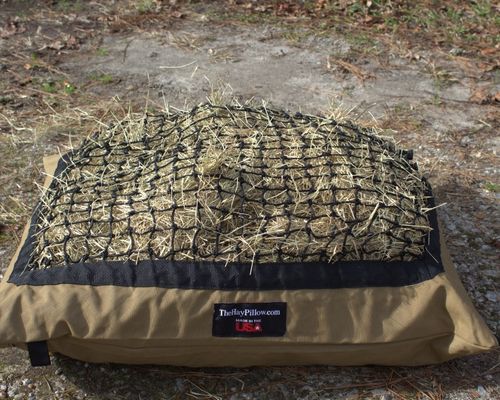
The original Hay Pillow is shaped like an actual pillow. It’s rectangular or square, with a netted top and solid fabric bottom. One edge of the Hay Pillow is a full length zipper. To use the pillow, you unzip, stuff with hay, zip closed, and drop the pillow off in the stall or pasture.
Why Use a Hay Pillow?
The Hay Pillow is a uniquely designed slow feeder for forage.
Slow feeders for horses are growing in popularity, for good reason. More equestrians are becoming aware that horses need forage moving through the gut at all times, not on a meal-based schedule. But for many horses, 24/7 forage should not mean all-you-can-eat access to hay, and that’s where slow feeders come in.
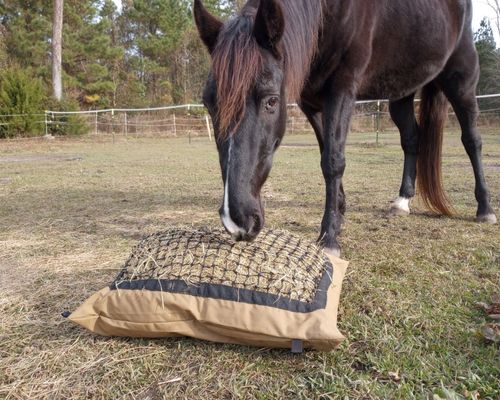
Slow feeders for forage include the tried-and-true hay net, freestanding solid feeders, and rolling solid options like Hay Play balls (if you’ve never seen one, here’s the Hay Play on Amazon).
The Hay Pillow for horses (though you can use it for other livestock too!) aims to combine most of the good features of all these items. Natural feeding posture, ease of use and care, and 4 mesh size options are all selling points, and reasons why the Hay Pillow has a very enthusiastic user base.
How to Use a Hay Pillow for Horses
The quick version: to use a Hay Pillow you simply unzip the zippered end and open the bag. Stuff it with hay and then zip it back up. Place net-side-up in your horse’s stall or turnout space.
The Hay Pillow company has several options available for sale, including different mesh sizes, a trailer option, and pillows appropriate for hanging up rather than using on the ground.
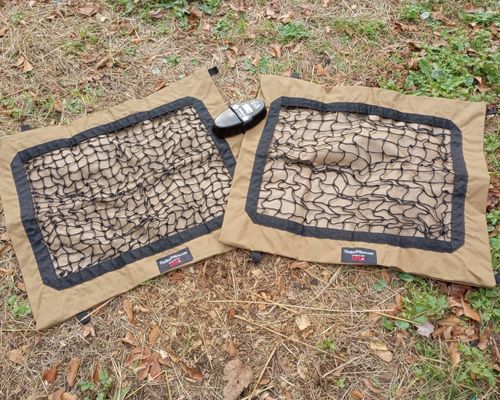
If you want the deep dive into which product is best for your horse and how to use each one, I definitely recommend the website or simply reaching out to their customer service (that wasn’t included in my review, but I can confirm that they’re easy to contact and very helpful!).
The Test
I used and compared two standard Hay Pillows through 3 seasons – fall, winter, and spring.
The Pillows had different mesh sizes – 1.25 inch and 1.75 inch – to see how the difference affected feeding rate.
I used both Hay Pillows in a variety of conditions and locations, including stall, grass pasture, dirt, and mud. Because hays have varying textures, I used different cuttings of bermuda and timothy hay. As much as possible, I tried to use the Pillows in a wide range of weather.
Quality and Construction

Overall Quality Rating: 5/5
The Hay Pillow is a very well made product. If buying items produced in the USA is important to you, it checks that box as well and the quality shows.
The back and margins of the top are made from heavy duty Cordura, a synthetic fabric that’s quite water resistant. It’s the same stuff as quality backpacks and duffel bags. Cordura comes in several thicknesses and the Hay Pillow uses the really tough stuff, so it’s highly puncture and tear-resistant.

Cordura is also a “ripstop” material. This means that if a tear or puncture does happen (not sure how – if you throw it onto a bed of spears, maybe?) it won’t continue to grow. You can also patch it at home using a sewing machine or even hand needle and thread. The Pillow’s seams are good with good quality synthetic thread and stitchwork.
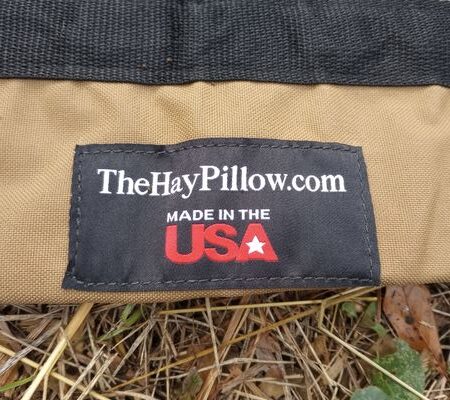
The standard Hay Pillow is currently only available in one color, a neutral brown. As the company grows, I would love to see more color options – not just because I love color, but also to make the pillow easier to see in the paddock and to allow stables to color-code their nets by mesh size. But the tan color is really nice and goes with pretty much any environment. Adding color options adds material and labor cost, and really the performance is the important thing.
The zipper is the feature of the Hay Pillow for horses that gets the most chatter on social media. But from a materials standpoint, the quality is good. The zipper is rugged and designed for heavy use.
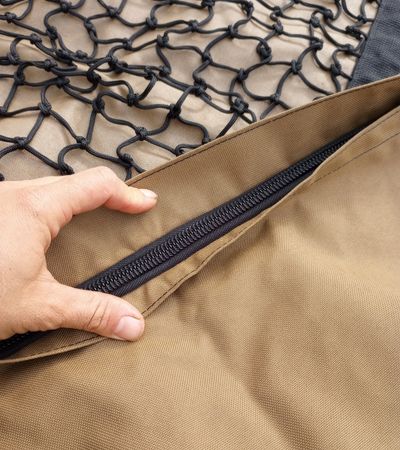
Usability and Performance

Overall Performance Rating: 4.5/5
Overall the Hay Pillow is easy to use, for horse and human. There is a small learning curve if you’re using a slow feeder for the first time – or if you’re like me and have some unhealthy coping mechanisms from using plain hay nets.
The fact that the zipper is the full length of the side of the pillow is excellent. Unlike a hay net, the Hay Pillow will stay open as you begin to fill it. This isn’t the best photo ever taken, but you can see that when opened, the pillow stays open:
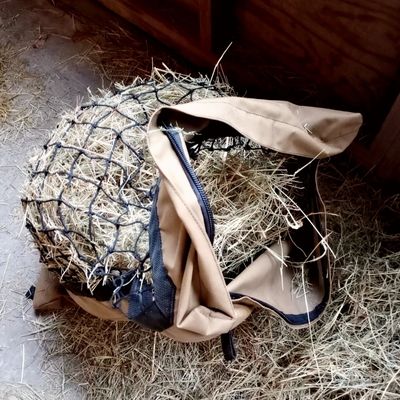
I was also a fan of the double flap that covers the zipper when the bag is closed up. It’s a nice design feature that helps keep the zipper clean. In normal use, I found that the zipper was consistently easy to use. I definitely recommend making sure the flap is closed if you’re using the bag in muddy conditions. If it does come in from the field crusted in mud, the zipper will be difficult to open.
The half a star off is from how the bag’s size and capacity require a touch of extra time to fill with certain hay types. It’s not a big issue, but worth knowing about in advance. So let’s go into some detail!
Size and Capacity
I don’t consider size or capacity to be a problem because the Hay Pillow is meant to be used in a certain way and filled with a reasonable amount of hay. To their credit, the Hay Pillow’s instructions makes this clear. Stated capacity on the website is 8 pounds of hay (I, a chronic overfiller, usually got 10 pounds in).
But I had to relearn my habit of trying to stuff half a bale at a time into the Pillow, and you should too if you want to have success with the product.
The Hay Pillow for horses is rectangular. When I hastily stuffed entire flakes of long-stem hay into the net, there was too much hay in the wrong places (trying to stick out the opening) and not quite enough in others (gaps where the flake of hay wasn’t the same size as the Pillow).
My advice: pay attention to capacity and if you have long stem hay, break up the flakes a little before you stuff. This will fill all the corners and let you get the maximum capacity.

Shorter-stem bermuda, alfalfa and timothy hays worked extremely well with no extra fiddling.
Speaking of capacity: standard sized Hay Pillow do not hold as much hay as a large hay net. This is by design. Don’t expect one pillow to hold a horse’s entire daily amount of forage in one go. As we’ll cover, overstuffing the pillow can lead to zipper failure.
Instead, use a team of Hay Pillows, or additional forage feeders. Yes, you do have to fill two items rather than one net, and we are all busy these days – but having more than one hay station is better anyway. Grazing behavior for horses involves taking a small amount of food from an area and moving on.
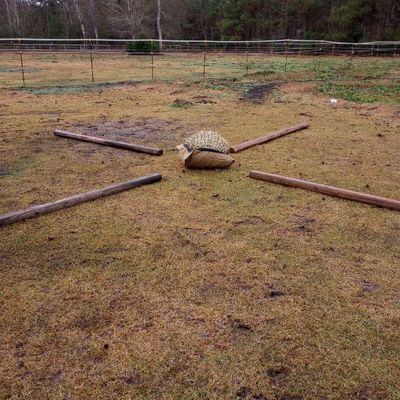
With several Pillows or other forage options in the paddock, horses will move between them as they eat, getting exercise and stimulation.
Feeding Behavior

Overall Behavior Rating: 5/5
The Hay Pillow gets very high marks for promoting natural feeding behavior.
For horses, the most natural way to eat is by taking small bites of forage with the head near the ground. In other words, eating in a way that looks a lot like grazing on pasture.
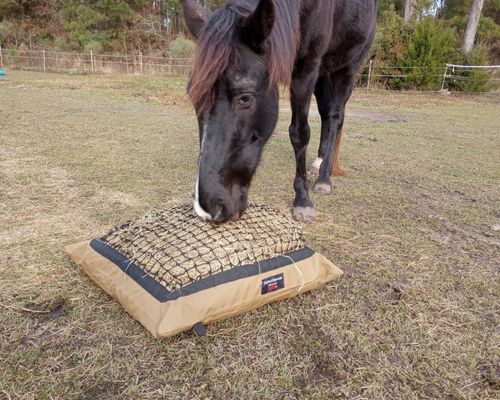
The Hay Pillow does this very well, in my experience better than most hay nets. I was extremely happy with how quietly horses ate from the pillow.
The secret is in the solid backing fabric and pillow-like shape. The low rectangular shape discourages rolling or overturning and the solid back keeps the hay from escaping.
Once horses practiced with it, I didn’t have much issue at all with overturning, tossing, or other “extra” behavior. Just slow, gentle grazing – exactly what you want out of a slow feeder for forage.
I tried two mesh sizes, 1.25 inch and 1.75 inch. Both performed very well, with the smaller mesh making the hay last longer (as intended). At capacity, I found that a single pillow held about half a day’s forage for an average sized, moderate- to easy-keeper horse. Two Hay Pillows covered a full 24 hour period, which is exactly what I wanted from a pasture forage solution.
On a related note, the Hay Pillow performed better than any other feeding option in rainy weather. Nets tend to sog up and are hard for the horse to get hay from when wet; the Hay Pillow still allowed emptying even when left out in the weather. And the Cordura backing keeps muddy water from seeping into the hay even when used on wet ground.
Durability

Overall Durability Rating: 5/5
In my testing, I evaluated the durability of the three parts of the Hay Pillow: the solid backing, the net, and the zipper. Overall, they each performed very well, and we’re into our sixth straight month of use. Both Hay Pillows still look brand new.
The backing fabric: Strong stuff. 1,000 denier Cordura is a great design choice. My Pillows got tossed around, stepped on, frozen/thawed, repeatedly slugged through the mud, and dragged through briars. They take a licking and keep on kicking.
The net: No holes. I’ve found in testing and using a variety of net items that durability is partly a matter of product quality and partly how calmly the horse interacts with the net. The Hay Pillow has held up beautifully and I have a horse who regularly performs unauthorized surgery on other nets.
With those features covered, if you’ve read reviews of the Hay Pillow on social media, a 5/5 durability rating might be controversial. Some online comments remarked that the zippers didn’t hold up – the term a few used was “exploded.” So I went into the test paying special attention to the zipper.
About That Zipper
In using the product in a variety of conditions, I didn’t experience any zipper issues. No failure, no misalignment and no exploding.
Looking critically, I can see where the zipper could run into trouble under some types of use. For example, any zipper will struggle in these conditions:
- Zipping under excessive pressure (stuffing the pillow too full and trying to zip it up)
- Hay interfering with the zipper’s teeth, causing a weak zip
- Dirt or sand crusting the zipper and not cleaned away before opening (gradually wearing out the zipper’s teeth)

For success with the Hay Pillow, you need to treat it like the specialty product it is, not a free-for-all hay net that just happens to have a zipper. A drawstring or rope is low-tech, a zipper isn’t.
This means filling the Hay Pillow to appropriate capacity, and then pushing down the hay slightly so that it’s clear of the zipper before you close it up. Make sure there’s a little slack in the fabric as you zip – like sucking in your tummy a bit before zipping up snug jeans.


Mud and sand will also interfere with the zipper and weaken it if you use the zip repeatedly when the Pillow is crusty. But I live in sandy mud country (both! At one time!) and this wasn’t an issue because the pillow is otherwise super durable. To clear dry mud off the zipper, just whack the Pillow against the barn floor. Remove wet mud or silt with a hose. Then zip/unzip as normal.
In more average conditions – dirt, gravel, grass, and stall shavings – the zipper performed beautifully and consistently in my testing. It’s not a light duty zipper by any means.
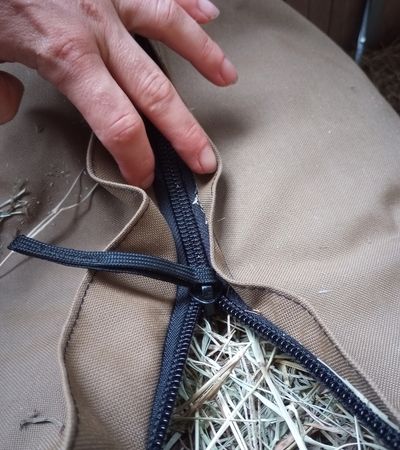
Price Point
The standard size Hay Pillow ranges from about $70 to $80 depending on mesh size.
That’s a chunk for most of us, though this price is similar to other specialty forage products. A single Hay Pillow will run you about as much as a high quality square-bale net; a few Pillows for your horses’ turnout will be about as much as a round bale net or solid forage feeder.
The cost of the Hay Pillow is an honest reflection of the material quality and USA production. The materials used, especially the 1,000 denier Cordura, are pricey (because they’re the right stuff for the job). It’s not a dollar-store piece of equipment.
Lastly, the Hay Pillow’s design means it can’t be machine-produced. Each one is assembled by hand.
For me, the purchase cost is a fair reflection of the Pillow’s quality, its performance as a feeding tool, and its expected lifespan.
Review Conclusion: I’m a Fan, Honestly
The Hay Pillow performed extremely well in my testing. It did a great job in a variety of environments. And the horses ate from it correctly, calmly, and safely.
The Hay Pillow got very high marks for durability, quality, and natural feeding behavior. It’s also quite easy to use, though filling it is different than stuffing a hay net or lidded solid feeder. I took one single point off for having to somewhat carefully clear hay from the zipper and ensure the Hay Pillow isn’t overstuffed.
So for me, the Hay Pillow gets an almost perfect review and is now part of my permanent lineup of forage feeding devices.
Should You Buy a Hay Pillow for Your Horse?
There’s no such thing as a perfect hay feeding item for all horses, all equestrians, and all stables – that’s why choosing the right hay feeding device for your situation is important.

But I’m pretty comfortable in saying that for most equestrians, especially those keeping just a few equines at home, Hay Pillows are worth the hype. If you haven’t bought one yet, I encourage you to try it.
If any of these describe you, definitely put the Hay Pillow on your radar:
- Natural feeding posture is important to you
- You prioritize involvement in your horse’s diet, rather than set-and-forget care
- Your horse gets a set amount of hay each day but you want to slow down consumption
- You want to create multiple hay stations in your paddock or track
- Your ground is often sandy, wet, or muddy and you’re over gross hay nets
- Your horse is barefoot
And here’s an honest take on situations/expectations where the standard Hay Pillow may not be quite what you’re looking for:
- You don’t have a schedule that allows you to fill the Pillow regularly or the willingness to use several at once (in this case, a whole bale net is a better choice)
- You want a hay feeder that can be stuffed to the max each time you fill it
- Your horse has shoes (no net is safe for shod horses)
The conclusion of my novel of a Hay Pillow review: a high quality product that creates high quality outcomes for horses, and I absolutely recommend it.
For more information on Hay Pillows, the website has a fabulous blog along with plenty of detail on each product page. I also found Hay Pillow customer service to be outstanding, and if your questions aren’t answered by the website, start a conversation using their contact form.
Happy foraging!